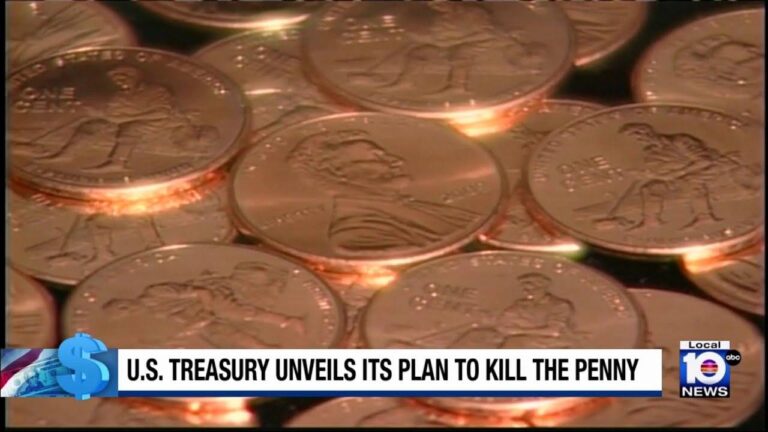The United States Treasury has officially confirmed the end of the penny, marking the conclusion of an era for the iconic one-cent coin that has been in circulation for over a century. In a recent announcement covered by the BBC, officials cited rising production costs and dwindling usage as key reasons behind the decision to discontinue the penny. This move is expected to have significant implications for American currency and everyday transactions, stirring debate among consumers, economists, and policymakers alike.
US Treasury Announces Official Phase-Out of the Penny
The US Treasury Department has officially confirmed that the penny will be retired from circulation, marking the end of an era for the smallest denomination coin in American currency. This decision comes after years of debate over the cost of production versus the coin’s diminishing value in everyday transactions. Officials cited that the penny now costs nearly twice its face value to produce, making it economically unsustainable.
Key points regarding the phase-out include:
- The transition will be gradual, with pennies being withdrawn from circulation over the next 18 months.
- Retailers will be encouraged to round cash transactions to the nearest five cents.
- Collectors and numismatists may still find pennies valuable, but new minting will cease immediately.
- Other coins, such as nickels and dimes, will continue to be produced and circulated.
| Impact Area | Details |
|---|---|
| Cost Savings | Estimated $100 million annually |
| Transaction Adjustments | Rounding to nearest 5 cents |
| Environmental Benefit | Reduced metal mining and waste |
| Public Sentiment | Mixed reactions from nostalgia to acceptance |
Economic Implications of Ceasing Penny Production Explained
Discontinuing penny production is poised to create a ripple effect across multiple facets of the economy. One immediate area of impact will be the reduction in manufacturing costs for the US Mint, which currently spends more than one cent to produce each penny, leading to a yearly net loss. This shift could allow redeployment of resources towards more cost-efficient coinage, streamlining monetary circulation and potentially increasing overall fiscal efficiency.
However, the change extends beyond production economics. Retailers and consumers may face adjustments due to rounding rules in cash transactions, influencing pricing strategies and consumer behavior. Experts predict the following consequences:
- Rounding Mechanisms: Cash payments rounded to the nearest five cents, affecting final sale prices.
- Pricing Psychology: Businesses may revise pricing to align psychological price points without the penny.
- Charitable Donations: Penny-based collection jars could see a decline unless adapted.
| Economic Factor | Potential Effect | Timeframe |
|---|---|---|
| Minting Costs | Savings of $30 million annually | Immediate |
| Retail Pricing Adjustments | 5-cent rounding adoption | Short-term (6-12 months) |
| Consumer Wallets | Less coin clutter, streamlined transactions | Mid-term |
Public Reaction and Retailer Adjustments to Penny Discontinuation
Consumers have exhibited mixed reactions following the announcement about the penny‚Äôs discontinuation. While many welcome the move, citing the coin as outdated and inconvenient, others express nostalgia and concern over price rounding and potential inflationary effects. Social media platforms have become a hotbed for debate, with hashtags like #ByeByePenny trending and users sharing personal stories about the coin’s role in American culture. Retailers, anticipating shifts in cash transactions, are preparing strategies to ease the transition for both customers and staff.
Several major retail chains have already outlined adjustments to their payment policies, including rounding totals to the nearest five cents during cash transactions. The table below highlights some early adopter retailers and their approaches:
| Retailer | Rounding Policy | Customer Communication |
|---|---|---|
| ShopSmart | Round up or down to nearest 5 cents | Signage and checkout notifications |
| QuickMart | Round up only | Staff training and digital receipts |
| Daily Essentials | Offer digital change instead of coins | Email newsletters and app alerts |
- Contactless payments are being heavily promoted to minimize reliance on cash handling.
- Staff training sessions emphasize clear communication and customer reassurance.
- Public outreach includes educational campaigns about the rationale behind the penny’s retirement.
Experts Recommend Strategies for Smooth Transition to Pennyless Transactions
Financial experts emphasize the importance of gradual adaptation to a pennyless economy, highlighting the need for comprehensive public education campaigns. Retailers are urged to implement precise rounding mechanisms, ensuring consumers and businesses experience minimal disruption during cash transactions. Embracing digital payment platforms, which bypass the need for physical change, is also highly recommended to streamline everyday purchases and reduce dependency on coins.
To aid in this smooth transition, experts suggest governments and financial institutions collaborate on clear guidelines for rounding rules and transparent communication strategies. The following table outlines key strategies and their expected impacts:
| Strategy | Impact |
|---|---|
| Public Education Campaigns | Increase awareness and acceptance |
| Clear Rounding Rules | Prevent pricing confusion |
| Promote Digital Payments | Reduce cash handling costs |
| Retailer Training | Ensure smooth checkout experiences |
In Retrospect
As the US Treasury officially confirms the end of the penny, a significant chapter in American currency history comes to a close. While the decision reflects economic realities and changing consumer habits, it also marks the end of an era that has endured for over a century. As the nation adapts to a penny-free future, the move prompts reflection on the evolving nature of money in the digital age and the balance between tradition and practicality in shaping the country’s financial landscape.




